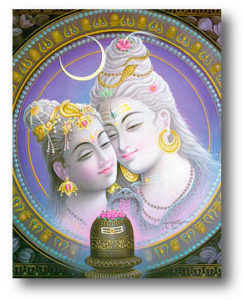
 hiva is one of the principal gods of the Hindu pantheon, and in the textbook view of Hinduism, he is one of the ‘trinity’ of Hindu gods, of which the other two are Brahma and Vishnu. Shiva is represented as the Destroyer, Brahma as the Creator: Vishnu holds the universe in balance, acting as the Preserver. However, the worship of Brahma is almost unknown in India, and Indian sectarian history and conflict resolves itself largely, though by no means exclusively, into a struggle between the adherents of Shiva, called Saivites, and the followers of Vishnu or Vaishnavites. The rival claims of the followers of Shiva and Vishnu are found in most Indian texts, stretching as far back as the Mahabharata, but there are also attempts to reconcile these claims with the argument that Shiva and Vishnu are in reality one. Thus, according to the Harivamsa, there is “no difference between Shiva who exists in the form of Vishnu, and Vishnu who exists in the form of Shiva.”
hiva is one of the principal gods of the Hindu pantheon, and in the textbook view of Hinduism, he is one of the ‘trinity’ of Hindu gods, of which the other two are Brahma and Vishnu. Shiva is represented as the Destroyer, Brahma as the Creator: Vishnu holds the universe in balance, acting as the Preserver. However, the worship of Brahma is almost unknown in India, and Indian sectarian history and conflict resolves itself largely, though by no means exclusively, into a struggle between the adherents of Shiva, called Saivites, and the followers of Vishnu or Vaishnavites. The rival claims of the followers of Shiva and Vishnu are found in most Indian texts, stretching as far back as the Mahabharata, but there are also attempts to reconcile these claims with the argument that Shiva and Vishnu are in reality one. Thus, according to the Harivamsa, there is “no difference between Shiva who exists in the form of Vishnu, and Vishnu who exists in the form of Shiva.”
The name of Shiva does not appear in the Vedas, but he was earlier known as Rudra, or the Fearful and Destructive One. Though the power of destruction, which in the most intensified form makes him a Bhairava (‘The Terrible Destroyer’), remains Shiva’s principal attribute, the corollary of that attribute, namely creation or fertility, is also central to the identity of Shiva. This aspect of Shiva is represented by the lingam, or phallus, which is worshipped as a representation of Shiva. Sometimes the female genitals, or yoni, are placed alongside the lingam. These are not the only iconic representations of Shiva: he appears as the yogi, in whom are concentrated all the powers acquired by meditation, penance, and a life of austerity, or as the naked ascetic Digambara, with matted hair and a body smeared with ashes. In Indian art, Shiva can also be recognized by the presence of Nandi, or the bull, which is his vehicle; or by the trishul or trident, the weapon that he carries with him. He is known, according to some ancient authorities, by 1,008 epithets: among these are Nilakantha, “the blue-throated”; Panchanana, “the five-faced”; Nataraj, “The Lord of Dancers”; and Trilochana, “the three-eyed”. The “third eye of Shiva” has become the stuff of much legend, not only in India: it is with this eye that Shiva destroyed Kama, the
Lord of Love, who had the impunity to tempt Shiva with amorous thoughts of his consort Parvati as he sat in penance. Shiva is often shown with Parvati; he is also shown as ardhnarishwara, half-man and half-woman. To begin to enumerate Shiva’s various forms, epithets, and representations is to unravel the multiple layering of Indian civilization. There are, needless to say, innumerable pilgrimage sites associated with Shiva, and temples to him are to be found in every nook and cranny of India. According to Hindu mythology, Shiva’s home is on Mt. Kailash, at the foot of which is the purest and holiest lake to be found anywhere, Manasarovar [from the Sanskrit manas, which gives this site its name].


